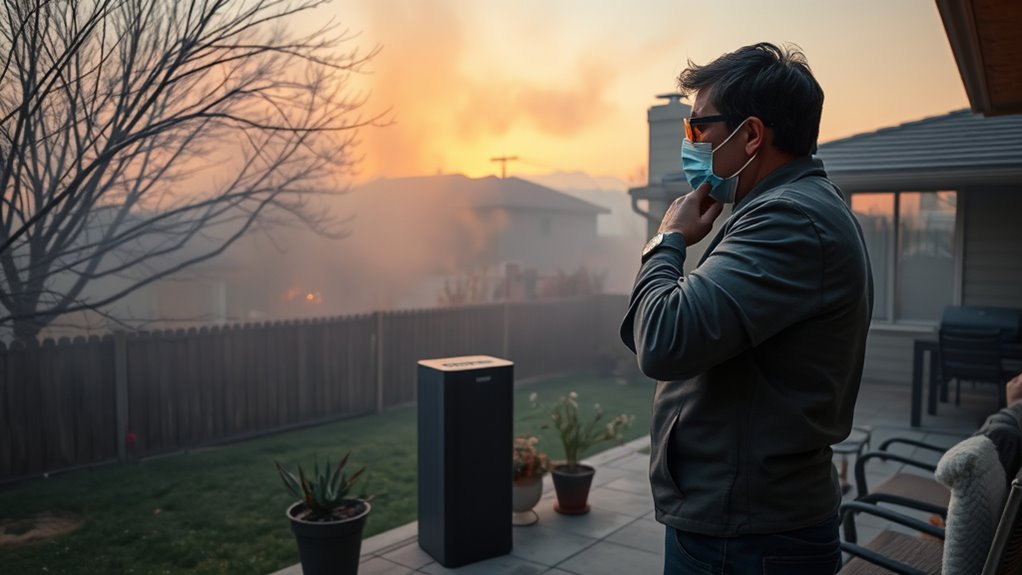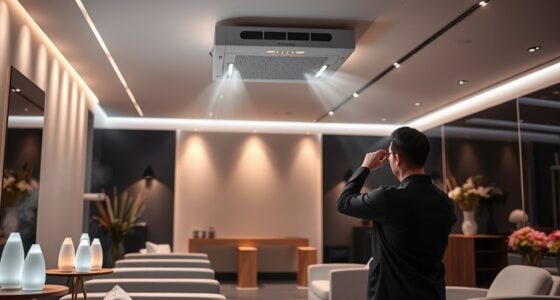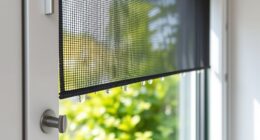To protect your home from wildfire smoke, keep windows and doors closed and turn off exhaust fans that bring in outdoor air. Use HEPA air purifiers, and upgrade your HVAC filters to high-efficiency options, replacing them regularly. Seal gaps around windows and doors to limit smoke entry. Monitor indoor air quality and adjust ventilation based on local reports. Implementing these steps can make a big difference—learn more to guarantee your home stays safe during wildfire events.
Key Takeaways
- Keep windows and doors closed and shut ventilation systems to prevent outdoor smoke from entering your home.
- Use HEPA-filter air purifiers in main living areas and bedrooms to reduce indoor particulate levels.
- Seal gaps around windows and doors with weather stripping or draft stoppers for added protection.
- Monitor indoor air quality with sensors and adjust ventilation or filtration accordingly.
- Stay informed about outdoor air quality and re-enable ventilation only when air conditions improve.

Have you ever wondered how wildfire smoke can infiltrate your home even when you’re indoors? It’s unsettling to think that, despite staying inside, you might still be breathing in harmful particles drifting through tiny gaps or cracks. Wildfire smoke contains fine particulate matter, which can easily seep through windows, doors, and ventilation systems. To protect yourself, understanding how to improve air quality through effective air filtration and ventilation strategies is essential. These methods help reduce indoor pollution and keep the air safer for you and your family.
Air filtration is one of the most effective ways to combat wildfire smoke indoors. High-efficiency particulate air (HEPA) filters are designed to trap tiny particles, including those found in wildfire smoke. If you have a central HVAC system, consider upgrading your filters to HEPA-rated options, and make sure to change them regularly—preferably every one to three months during wildfire season. For portable air purifiers, choose models with HEPA filters and ensure they’re appropriately sized for the rooms you want to protect. Placing these purifiers in bedrooms and common areas can markedly improve indoor air quality, especially when outdoor air quality is compromised.
Upgrade to HEPA filters for central HVAC and portable purifiers to improve indoor wildfire smoke protection.
In addition to filtering the air, ventilation strategies play a key role in limiting smoke infiltration. While fresh air intake is essential in normal conditions, during wildfire events, it’s best to minimize outdoor air exchange. Keep windows and doors closed as much as possible, and turn off exhaust fans that draw in outside air, such as bathroom and kitchen vents. If your home uses a mechanical ventilation system, consider adjusting or shutting it down to prevent smoke from entering. For homes with controlled ventilation, installing an indoor air quality monitor can help you track particulate levels and decide when it’s safest to open windows or turn on fans. When outdoor air quality improves, you can cautiously open windows or activate ventilation systems to flush out indoor pollutants, but always monitor air quality reports first. Additionally, sealing gaps around windows and doors with weather stripping or draft stoppers can further prevent smoke from sneaking inside.
Combining air filtration with strategic ventilation is your best defense against wildfire smoke indoors. Sealing gaps around windows and doors with weather stripping or draft stoppers can further prevent smoke from sneaking inside. Using an air purifier with a timer can ensure continuous air cleaning, especially overnight. Staying informed about local air quality updates through apps or government alerts helps you make timely decisions about ventilation. Overall, taking these proactive steps helps you maintain a safer indoor environment, reducing your exposure to harmful wildfire smoke and ensuring that your home remains a refuge even during smoky conditions outside.
A good understanding of indoor air quality can help you better assess when to ventilate and when to keep smoke out, ensuring optimal safety for your family.
Frequently Asked Questions
How Often Should Air Filters Be Replaced During Wildfire Events?
During wildfire season preparedness, you should replace your air filters every 1 to 2 months, or more often if you notice decreased airflow or increased dust. Regular air filter maintenance helps keep indoor air quality high and reduces wildfire smoke exposure. In smoky conditions, consider upgrading to high-efficiency filters and checking them frequently to make certain they’re working effectively. Staying proactive safeguards your health during wildfire events.
What Are the Best Indoor Plants for Filtering Wildfire Smoke?
You should consider indoor plant types like snake plants, spider plants, and pothos for filtering wildfire smoke. These plants are great air purification methods because they absorb toxins and improve air quality naturally. Place them in different areas of your home to maximize their benefits. Regular watering and proper placement help them thrive and enhance your indoor environment, making it safer during wildfire events.
Can Wildfire Smoke Infiltrate Through Windows and Doors?
Wildfire smoke can sneak in like an uninvited guest through tiny cracks. You might think open windows and doors keep fresh air flowing, but they also invite smoke. To block this infiltration, you need to check your window sealing and door insulation. Properly sealing these gaps creates a fortress, stopping smoky air from entering and keeping your home safer and cleaner during wildfire events.
Are There Any Portable Air Purifiers Recommended for Wildfire Smoke?
Yes, portable purifiers are highly recommended for smoke removal during wildfires. Look for models with HEPA filters, as they effectively trap tiny smoke particles, improving indoor air quality. Choose a purifier that covers your room size for maximum performance. Regularly change filters to maintain efficiency. Portable purifiers are convenient, easy to use, and essential for reducing health risks when wildfire smoke infiltrates your home.
How Can I Tell if My Home’s Ventilation Is Compromised?
Think of your home’s ventilation as its lungs—if you’re unsure, check your HVAC system for proper operation, like clogged filters or leaks. You can also measure the air exchange rate; if it’s low, fresh air isn’t entering effectively, and indoor air quality suffers. Notice persistent odors, stuffiness, or dust buildup, which signal compromised ventilation. Regular maintenance and testing help guarantee your home breathes freely, even during wildfire seasons.
Conclusion
So, next time you notice wildfire smoke outside, remember it’s no coincidence that your home’s air quality drops. By keeping windows closed, using air purifiers, and checking your filters, you can protect yourself without even thinking twice. It’s funny how small actions make a big difference—sometimes, the best defenses are right at your fingertips. Stay vigilant, stay safe, and trust that a little preparation can keep the smoke out of your space when it matters most.










